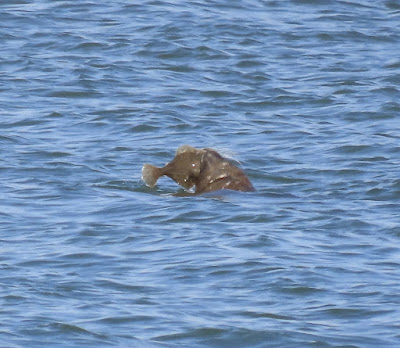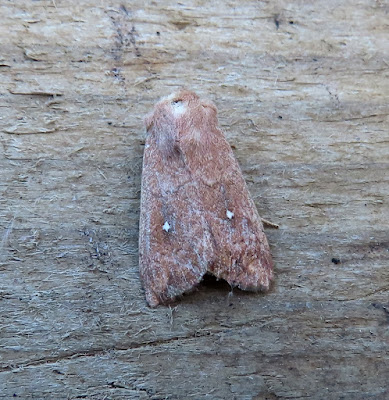Almost of greater interest in Feldy View on Tuesday was a record number of 25+ willow warblers feeding in the birches and oak trees, some calling and sub-singing. A willow warbler was also feeding in the Firs Chase garden.
A walk along the Strood seawall on Tuesday produced three sand martins, ten swallows, sedge warbler, two reed warblers, blackcap, two whitethroats, lesser whitethroat and fifty linnets. Along the channel were 150 black-tailed godwits, 150 redshank, 20 grey plover, ten turnstones, six common terns, golden plover, three grey herons and ten little egrets. A male marsh harrier hunted over the fields and a buzzard perched on a bush.
Six green sandpipers were seen by Andy flying off the saltmarsh beside the Firs caravan site and they headed over to Copt Hall on Tuesday.
Early evening at Coopers Beach on Tuesday, Steve Entwistle saw nine dunlin, whimbrel, curlew, 106 golden plover and two ringed plover on the Rewsalls marshes.
Along the Strood channel on Monday 15th were ten golden plover, 25 grey plover, two ringed plover, four common terns, 150 black-tailed godwits and 150 redshank.
Along the Strood channel on Monday 15th were ten golden plover, 25 grey plover, two ringed plover, four common terns, 150 black-tailed godwits and 150 redshank.
There were lots of small birds feeding in the stubble field beside the central ditch with a whinchat being the most notable. Also two juvenile stonechats, 100 linnets, 50 house sparrows, 25 skylarks, ten corn buntings, ten reed buntings, Cetti's warbler, four reed warblers, three whitethroats, three yellow wagtails, sedge warbler, two greenfinch, ten goldfinch, four willow warblers, as well as two buzzards.
At Maydays on Monday morning Martin Cock saw three hobbies, male marsh harrier, common sandpiper, golden plover, 20 grey plover, willow warbler, chiffchaff, sedge warbler, reed warbler, whitethroat and lesser whitethroat.
A hummingbird hawk-moth visited the Firs Chase garden briefly on Monday.
It looked like there was a young oystercatcher chick just visible beside the parent bird on the back of an oyster fishing boat in the Strood Channel on Sunday 13th. An oystercatcher has been sitting on a nest among a coil of old ropes for what seemed like an eternity.
Two red kites were seen circling near the Strood causeway for several minutes on Sunday morning, drifting slowly over to the Mersea side. Later one of the red kites seemed to be feeding on something in a stubble field, below the bowls club.
Birds of interest seen from the Strood seawall on Sunday included 18 grey plover, 150 black-tailed godwits, two Mediterranean gulls, whitethroat, yellow wagtail, a chiffchaff by the reservoirs, also a painted lady by the seawall.
Steve Entwistle reported seeing at Meeting Lane five lesser whitethroats, eight goldfinches while nine long-tailed tits were in Shop Lane on Sunday.
A gannet was photographed by Judith Sorrell on Sunday as it sat on the water among the swimmers off the West Mersea beach, presumably a poorly bird.
A very worn female common blue was feeding at the lavender flowers in the Firs Chase garden on Sunday, also a willow warbler feeding in the birch tree in the garden.
A wasp spider was photographed by Andy Field in the field near the Shop Lane seawall on Saturday 13th. A grey squirrel was seen beside the Fishponds Wood, and has been reported. A chiffchaff and young sparrowhawk calling were in the wood. A weasel crossed the East Mersea road near Weir Farm, narrowly avoiding being run over.
At Maydays on Saturday a whinchat was seen near the seawall close to the dyke near the Reeveshall field, also sedge warbler, Cetti's warbler, four reed buntings, three whitethroats and a flock of 25 chaffinches feeding on the farm track.
In the Pyefleet were 12 greenshank - six of them feeding on the mud opposite before being joined by another flock of six. Sixty grey plover, whimbrel, ten black-tailed godwits, common tern and four shelduck were also seen. A common seal was swimming along the channel while along the seawall were two common blues and a brown argus butterfly.
Late Saturday morning Steve Entwistle visited the Strood and reported four Mediterranean gulls, 11 corn buntings, two stonechats, six linnets, grey heron and 25 swallows.
A whinchat was in the Strood fields on Friday 12th, perching on bushes and then dropping to the ground to feed. Also three corn buntings, reed warbler, two whitethroats, two reed buntings and two yellow wagtails. In Feldy View there were seven willow warblers and another one in Firs Chase.
Nearly 200 black-tailed godwits were standing on the mud in the Strood channel behind the Dabchicks on Friday, before the incoming tide forced them to fly off. Also four grey plover in the channel.
A common seal had caught a flat-fish in the Strood channel and was holding it out of the water before swallowing it. The second day running the seal has been in the Strood channel.
At Maydays farm on Friday morning Martin Cock reported seven green sandpipers flying over, two common sandpipers, seven greenshank, whimbrel, three grey plover, Cetti's warbler, two buzzard, two marsh harrier and a wasp spider.
There was drama in Michael Thorley's East Mersea garden near Meeting Lane when a sparrowhawk attacked a magpie before a second magpie arrived to attack the sparrowhawk. The magpies retreated and the sparrowhawk perched on a fence before flying off noisily to a tree next door.
Common darter at Michael's garden pond.
Also in Michael's garden were juvenile whitethroat, as well as young blue tits and great tits.
Two willow warblers were in Steve Entwistle's Empress Drive garden and one was also in Firs Chase, while Andy Field reported a hummingbird hawk-moth in his front garden in High St North.
Fifty black-tailed godwits, little grebe and a common seal were in the Strood channel while two kestrels were over the fields.
A wheatear was seen by Steve Entwistle in horse paddocks by Bower Hall farm track. Two willow warblers were in Martin Cock's garden first thing at The Coverts.
A toadflax brocade caterpillar feeding on purple toadflax in the Firs Chase garden, despite no adults being seen in the garden moth-traps this summer.




















No comments:
Post a Comment